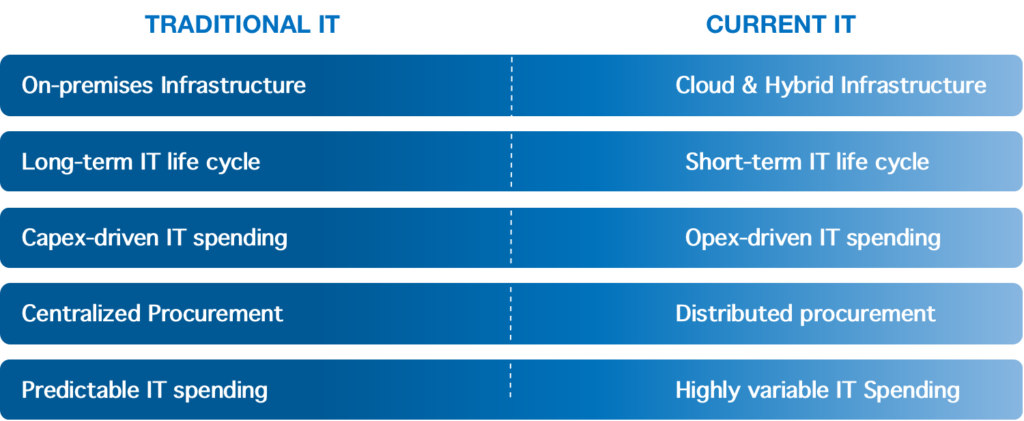The new IT spending
Recently we are witnessing an important transformation in the IT landscape, where the rapid evolution of technologies has redefined the way to face digital challenges and has opened new opportunities.
IT spending has seen a progressive metamorphosis, moving from a traditional context, characterized by on-premises infrastructures, capex-driven spending and high predictability, to a new context with huge investments in cloud and highly variable opex-driven spending.

The new context guarantees companies agility and resilience with respect to business needs, but on the other hand, it significantly complicates the financial governance of IT costs which are often perceived as a black box and difficult to manage.
This scenario is redefining the areas of relevance and creating new challenges for the CIO, who becomes a key figure for the alignment between the CEO’s strategic objectives and the Cost Management reduction and Cash-Fow preservation requested to the CFO.

The answer to the aforementioned challenges cannot be found in transversal cost cutting initiatives, especially in companies that see IT as a business high value enabler. The solution must be found in explaining the value that IT brings to business functions, thus connecting digital initiatives to specific business results.
As of today, according to a recent Gartner study, the connection between digital investments and business value is often difficult to evaluate and only 35% of CFOs believe that their teams can accurately evaluate the value creation of digital investments (2022 Gartner Finance Keynote Survey).
CIO and CFO therefore must be on the same page by defining a common vision and a structured performance management process that supports strategic decisions and maximize the return on IT investments.
How ITFM can help
IT Financial Management (ITFM) can play a crucial role, providing frameworks, operating models and technological tools for the economic-financial planning and control of digital spending. With ITFM it will be possible to actualize the value of IT costs, and it will be easier to exploit the power of technology to optimize business processes and to help the organization remain competitive as depicted below.

In terms of general framework, it is necessary to refer back to the fundamental pillars of cost management:
- Planning of IT spending by nature and cost destination, over different time horizons and in line with business objectives
- Punctual accounting recognition of economic-financial transactions related to the incurred expenses, which guarantees transparency for the analysis and enables the evaluation of performances
- Allocation based on shared and continuously refined drivers to assign costs and define tariffs for IT services provided to the various company functions.

In terms of ITFM operating model it is necessary to define the objects of control and the measurement methods. In this regard, a good reference can be the Technology Business Management (TBM) which proposes rules for classification and allocation of IT costs according to different industry taxonomies. Thanks to these models, once the cost and operational data have been researched and recorded, they can be standardized and classified to feed the specific allocation rules.

Once the operating model has been set up, it is also necessary to provide the organization with dedicated tools for data collection and the related analysis, as for any other management control processes. Several IT solutions can be adopted like performance management tools or “off-the-shelf” software specific for IT spending management.
In particular, the main vertical market software offer a series of standard features, such as:
- Automatic acquisition of financial and operational data (e.g. hybrid cloud and multicloud solutions data, etc.) and then structure a standard cost models.
- Cost management through forecasting and spending monitoring (e.g.: showbacks, chargebacks, etc.).
- Dashboarding with expenses consolidation for a complete picture of Total Cost of Ownership by each IT solution.
- Digital initiative portfolio management with end-to-end visibility of internal and external resources and overall budget.
The NTT DATA approach to ITFM projects
Finally, to understand how to evolve in the management of IT spending, it is crucial to evaluate the company maturity with respect to the listed topics. An in-depth analysis of these elements can provide an overview of the company’s current capabilities and help to identify priority areas to invest for improvements.












